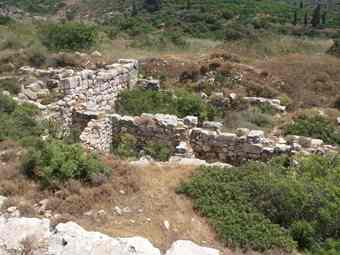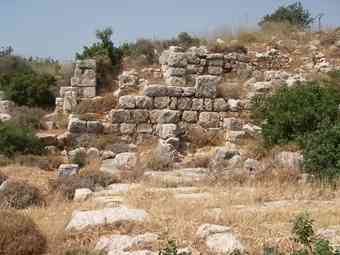In an area few Lebanese and virtually no tourists venture, far into heavily militarized and deeply conservative south Lebanon, sit the ruins of an ancient Greek civilization.
The Romans left a powerful archaeological footprint on the region - as sites like Baalbek and Palmyra attest - but evidence of a Greek legacy is more uncommon.
 It is appropriate, then, that ancient Umm el-Amed should be found deep in a field of overgrown thorn bushes, only several miles from the tense Lebanon-Israel border.
It is appropriate, then, that ancient Umm el-Amed should be found deep in a field of overgrown thorn bushes, only several miles from the tense Lebanon-Israel border.
A few weeks ago, I stopped by Dr. Paul Newson's office at the American University of Beirut to get some historical perspective on Alexander the Great's conquest through Lebanon. Newson, who has done extensive fieldwork throughout the Middle East, currently serves as a professor of archaeology at AUB.
Not long into our conversation, Newson suggested we visit the Umm el-Amed site, a place neither of us had been.
On the appointed day, we bussed down to the southern city of Tyre and met with relevant officials and security personnel to finalize our permission to travel further south. From Tyre we took a taxi down the coast, through banana fields and small villages, until we reached a small sign pointing towards the site.
We navigated a narrow country lane and parked the car, still with no ruins in sight. After surveying the scene for a few moments, Newson unleashed his inner Indiana Jones, and the wiry Brit sped off through thick underbrush up a hill.
A few moments later, he declared that he'd found the site. Even so, the terrain was rugged and the plant growth thick enough that it took us several minutes of scrambling before we found ourselves standing on the old temple complex of Milk Ashtart, on the edge of the ancient Umm el-Amed civilization.
 The foundation of the temple is still very much intact, and several column segments lie around it. Despite laying eyes on the site for the first time, Newson navigated the area easily, pointing out where the walls would have been, where the altar stood, and where the prostitutes lived. He pieced pottery fragments together, snapped photos for his records, and discussed Umm el-Amed's history.
The foundation of the temple is still very much intact, and several column segments lie around it. Despite laying eyes on the site for the first time, Newson navigated the area easily, pointing out where the walls would have been, where the altar stood, and where the prostitutes lived. He pieced pottery fragments together, snapped photos for his records, and discussed Umm el-Amed's history.
He also spotted a modern gunner's nest inside the ruins, piled high with sandbags and camouflaged with sticks and branches. The gunner's nest, along with the United Nations patrol we saw winding through the banana plantation below, reminded us of the odd setting in which we exploring a slice of ancient history.
Umm el-Amed's two temples were built roughly between 287 and 222 B.C. Long after the death of Alexander the Great, they were constructed in the Ptolemaic period, combining elements of Greek religion and the pagan tendencies of the local population.
Umm el-Amed was discovered by a French explorer in 1772, though the first excavations didn't take place until 1861.
After exploring the temple, Newson again set off through the brush. While I grimaced my way gingerly through the heavy thorn bushes, Newson charged ahead, pointing out other signs of this ancient civilization, including a second temple.
Newson said he doubted that serious excavations would ever take place on the site. The cost of such an undertaking, he noted, would be astronomical. I suggested that the site's location - far from the typical tourist track - might also be a deterrent.
It seems that until the winds of conflict die down in south Lebanon, and until some intrepid archaeologist decides to make the site his or her life's work, Umm el-Amed will remain largely free of tourists, except for the few who decide to brave the adverse political currents - and the thorns.
Author: Theodore May | Source: National Geographic [July 06, 2010]